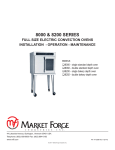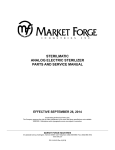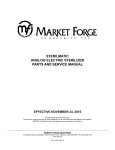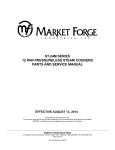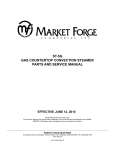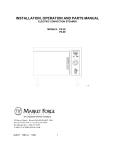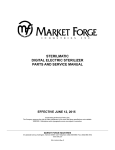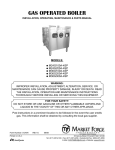Download Market Forge Industries Standard Depth8192 Specifications
Transcript
8100 & 8300 SERIES FULL SIZE GAS CONVECTION OVENS INSTALLATION - OPERATION - MAINTENANCE MODELS 8100 - single standard depth oven 8192 - double standard depth oven 8300 - single bakery depth oven 8392 - double bakery depth oven 44 Lakeside Avenue, Burlington, Vermont 05401 USA Telephone: (802) 658-6600 Fax: (802) 864-0183 www.mfii.com PN 14-0398 Rev A (9/14) © 2014 - Market Forge Industries Inc. Your Service Agency’s Address: Model Serial number Oven installed by Installation checked by TABLE OF CONTENTS IMPORTANT WARNING: Improper installation, adjustment, alternation, service or maintenance can cause property damage, injury or death. Read the installation, operation and maintenance instructions thoroughly before installing or servicing this equipment. INSTRUCTIONS TO BE FOLLOWED IN THE EVENT THE USER SMELLS GAS MUST BE POSTED IN A PROMINENT LOCATION. This information may be obtained by contacting your local gas supplier. FOR YOUR SAFETY Do not store or use gasoline or other flammable vapors or liquids in the vicinity of this or any other appliance. The information contained in this manual is important for the proper installation, use, and maintenance of this oven. Adherence to these procedures and instructions will result in satisfactory baking results and long, trouble free service. Please read this manual carefully and retain it for future reference. ERRORS: Descriptive, typographic or pictorial errors are subject to correction. Specifications are subject to change without notice. INSTALLATION Introduction.. . . . . . . . . . . . . . . . . . . . . . . . . . . . . . . . . . . . . . . . . . . . . . . . . . . . . . . . . . . . . . 2 Oven Location. . . . . . . . . . . . . . . . . . . . . . . . . . . . . . . . . . . . . . . . . . . . . . . . . . . . . . . . . . . . 3 Service Connections. . . . . . . . . . . . . . . . . . . . . . . . . . . . . . . . . . . . . . . . . . . . . . . . . . . . . . 4 Electric and Gas Connections. . . . . . . . . . . . . . . . . . . . . . . . . . . . . . . . . . . . . . . . . . . . . . 6 Assembly to Legs or Stand. . . . . . . . . . . . . . . . . . . . . . . . . . . . . . . . . . . . . . . . . . . . . . . . 7 Stacking the Ovens. . . . . . . . . . . . . . . . . . . . . . . . . . . . . . . . . . . . . . . . . . . . . . . . . . . . . . . 9 Start Up. . . . . . . . . . . . . . . . . . . . . . . . . . . . . . . . . . . . . . . . . . . . . . . . . . . . . . . . . . . . . . . . . 10 OPERATION Control Panel. . . . . . . . . . . . . . . . . . . . . . . . . . . . . . . . . . . . . . . . . . . . . . . . . . . . . . . . . . . . 11 MAINTENANCE Cleaning. . . . . . . . . . . . . . . . . . . . . . . . . . . . . . . . . . . . . . . . . . . . . . . . . . . . . . . . . . . . . . . . 12 Introduction IMPORTANT INFORMATION SERVICE Safe and satisfactory operation of your equipment depends on proper installation. Installation must conform with local codes, or in the absence of local codes, the National Fuel Gas Code, (ANSI Z-223.1 Latest Edition). In Canada installation should conform to installation codes for gas burning appliances and equipment standard (CAN1-B149.1 Natural Gas) or (CAN1-B149.2 Propane Gas). Installation of the equipment should be performed by qualified, certified, licensed and/or authorized personnel who are familiar with and experienced in state/local installation codes. Operation of the equipment should be performed by qualified and authorized personnel who have read this manual and are familiar with the functions of the equipment. Service of the equipment should be performed by qualified personnel who are knowledgeable with Market Forge cooking equipment. Electrical wiring from the Electric Meter, main control box or service outlet to appliance must be electrically grounded in accordance with local codes or, in the absence of local codes, the National Electric Code (ANSI/NFPA 70 Current). In Canada wiring should conform with Canadian Electrical Code (CSA-C22.1). SHIPPING DAMAGE CLAIM PROCEDURE The equipment is crafted and inspected carefully by skilled personnel before leaving the factory. The transportation company assumes full responsibility for safe delivery upon acceptance of this equipment. If shipment arrives damaged: Visible loss or damage: Note the damage or loss on freight bill or express delivery and signed by the person making the delivery. File claim for damages immediately: Regardless of the extent of damages. Concealed loss or damage: If damage is noticed after unpacking, notify the transportation company immediately and file a “Concealed Damage” claim with them. This should be done within fifteen (15) days from the date delivered. Retain container for inspection. INSTALLATION 2 Oven Location AIR SUPPLY AND VENTILATION LEVELING The area in front of, around and above the appliance must be kept clear to avoid any obstruction of the flow of combustion and ventilation air. Adequate clearance must be maintained at all times in front and at the sides of the appliances for servicing and proper operation. A carpenter’s spirit level should be placed on the oven’s center baking rack and the unit leveled both front-to-back and side-to-side. If it is not level, cakes, casseroles, and any other liquid or semi-liquid batter will not bake evenly, burner combustion may be erratic, and the unit will not function efficiently. Means must be provided for any commercial, heavy-duty cooking appliance to exhaust combustion waste products to the outside of the building. Usual practice is to place the unit under an exhaust hood. Filters and drip troughs should be part of any industrial hood. Consult local codes before constructing and installing a hood. If the floor is relatively smooth and level, the unit may be further leveled with adjustment in the foot of the leg. Units with casters must be leveled with shims. A unit will probably not return to the same position after being moved, requiring re-leveling after each and every move. Strong exhaust fans in this hood or in the overall air conditioning system can produce a slight vacuum in the room and/or cause air drafts, either of which can interfere with pilot or burner performance and can also be hard to diagnose. Air movement should be checked during installation; if pilot or burner outage problems persist, make-up air openings or baffles may have to be provided in the room. RATING PLATE The rating plate is located in front of the oven below the oven section. Information on this plate includes the model, and serial number, BTU / hour input of the burners, operating gas pressure in inches WC, and whether the appliance is orificed for Natural or Propane gas. Pilot lighting instructions are also located in the same area. WARNING LOCATION UNIT MUST BE CONNECTED ONLY TO THE TYPE OF GAS IDENTIFIED ON THE RATING PLATE! DO NOT MOUNT oven on a curb base. Use legs/casters provided. Adequate air space at the bottom and rear of the unit must be provided for proper venting of blower motor. DO NOT USE door to lift or move oven!!! All ovens must be installed on leg assembly or casters shipped with the unit. The leg/stand assembly parts or casters are shipped separately. CLEARANCE When installing ovens against combustible surfaces (rear or side walls) 6” (152mm) clearance is required. When installing ovens against non-combustible surfaces (rear or side walls) 0” clearance is required. 3 INSTALLATION Service Connections 8100 & 8192 STANDARD DEPTH OVENS SERVICE CONNECTIONS G Oven Interior Dimensions: 24” High x 29” Wide x 22-1/2” Deep (61mm High x 737mm Wide x 572mm Deep) Gas Connection - 3/4” (20mm) N.P.T. on the right hand rear of the appliance. Electrical Requirements: 120 VAC, 50-60 Hz, 1 Phase. Provided with a 6 foot power cord fitted with a standard three prong ground plug. Gas Pressure: Natural Gas- 5” W.C. Propane - 10” W.C. Installation Clearance: When installing ovens against combustible surfaces (rear or side walls) 6” (152mm) clearance is required. When installing ovens against non-combustable surfaces (rear or side walls) 0” clearance is required. The pressure regulator (supplied) is to be connected by the installer. Specify type of gas and altitude if over 2,000 feet, when ordering. DIMENSIONS ARE IN INCHES [MM] 2 [51] 2 [51] G G 29 [737] 22.5 [572] 37.75 [959] 29 [737] 22.5 [572] 37.75 [959] 135° 135° 40.25 [1022] 38 [965] 40.25 [1022] 24 [610] 34 [864] G 62 [1575] 28 [711] G 2.5 [64] 74 [1880] 34 [864] 30.5 [775] 28 [711] G MODEL 8100 6 [152] 6 [152] MODEL 8192 Figure 1 INSTALLATION 24 [610] 34 [864] 4 24 [610] G 2.5 [64] Service Connections 8300 & 8392 BAKERY DEPTH OVENS SERVICE CONNECTIONS G Oven Interior Dimensions: 24” High x 29” Wide x 26-1/2” Deep (61mm High x 737mm Wide x 673mm Deep) Gas Connection - 3/4” (20mm) N.P.T. on the right hand rear of the appliance. Electrical Requirements: 120 VAC, 50-60 Hz, 1 Phase. Provided with a 6 foot power cord fitted with a standard three prong ground plug. Gas Pressure: Natural Gas- 5” W.C. Propane - 10” W.C. Installation Clearance: When installing ovens against combustible surfaces (rear or side walls) 6” (152mm) clearance is required. When installing ovens against non-combustable surfaces (rear or side walls) 0” clearance is required. The pressure regulator (supplied) is to be connected by the installer. Specify type of gas and altitude if over 2,000 feet, when ordering. DIMENSIONS ARE IN INCHES [MM] 2 [51] G 29 [737] 26.5 [673] 41.75 [1060] 135° 44.25 [1124] 38 [965] 44.25 [1124] 34 [864] 62 [1575] 28 [711] 24 [610] 24 [610] 34 [864] G 74 [1880] 2.5 [64] 30.5 [775] 28 [711] G MODEL 8300 24 [610] 34 [864] 6 [152] G 2.5 [64] 6 [152] MODEL 8392 Figure 2 5 INSTALLATION Electric and Gas Connections ELECTRICAL CONNECTION The regulators supplied have 3/4” inlet /outlet openings and are adjusted at the factory for 5” WC (Natural gas) or 10” WC (Propane gas) depending on customer’s ordering instructions. Oven requires a 120 volt supply to operate the ignition system and blower. The supply cord provided along with the appliance is equipped with a three prong (grounding) plug for protection against shock hazard. The electrical service in the building must be equipped with a properly grounded three prong receptacle, in accordance with local codes, or in the absence of local codes, with the national electrical code, ANSI/NFPA 70-1987, in Canada, conform with Canadian electrical codes, CSA-C22.1. Prior to connecting the regulator, check the incoming line pressure, as these regulators can only withstand a maximum pressure of ½ PSI (14”WC). If the line pressure is beyond this limit, a step-down regulator will be required. The arrow shown on the bottom of the regulator body shows gas flow direction; it should point downstream to the appliance. The red air vent cap on the top regulator is part of the regulator and should not be removed. Do not cut or remove the grounding prong from this plug. Wiring diagram is located on the backside of the appliance. Any adjustments to regulators must be made only by qualified service personnel with the proper equipment. Disconnect power supply before cleaning or servicing. Connections Please check installer-supplied intake pipes visually and /or blow them out with compressed air to clear any dirt particles, threading chips, or other foreign matter before installing a service line. When gas pressure is applied these particles can clog orifices. All connections must be sealed with a joint compound suitable for LP gas, and all connections must be tested with a soapy water solution before lighting any pilots! NOTE: The oven can not be operated in the event of power failure. No attempt should be made to operate this appliance during power failure. GAS CONNECTION Single Deck oven requires one gas connection. Stacked oven requires two gas connections. The gas supply (service) line must be the same size or greater than the inlet line of appliance. Oven uses a 3/4” NPT inlet. Sealant on all pipe joints must be resistive to LP gas. Manual Shut-Off Valve This installer-supplied valve must be installed in the gas service line ahead of the appliance and regulator in the gas stream and in a position accessible in the event of an emergency. Pressure Regulator All commercial cooking equipment must have a pressure regulator on the incoming service line for safe and efficient operation, since service pressure may fluctuate with local demand. The pressure regulator comes with the oven. Failure to install the pressure regulator will void the equipment warranty! INSTALLATION 6 Assembly to Legs or Stand CASTER INSTALLATION ON LEGS If casters are provided, match holes on the caster with holes on the oven bottom base and fasten with bolts provided. NOTE: Front casters are locking type. Instructions for oven Leg (Stand) Assembly Assemble the leg assembly as follows: (For 8100 & 8300 Models Only) 1. Remove legs from package. 2. Line leg plate holes with holes at the bottom of the base. 3. Secure with (4) 3/8-16 bolts. RADIUS POINTING TO OUTSIDE 3/8-16 X 3/4 HEX BOLT (16) (4) LEGS Figure 3 7 INSTALLATION Assembly to Legs or Stand INSTRUCTIONS FOR OPTIONAL BOTTOM SHELF AND RACK GUIDE ASSEMBLY: Assemble as follows: (For 8100 & 8300 Models with Standard Leg Assembly already Installed) 1. Line up bottom shelf hole with holes on the legs and secure with #10 x 1/2 SMS as shown on detail “B” 2. Fold up the inner tab about 90○ on each leg using pliers. Fold as shown on detail “A” 3. Insert (Bottom Rack Assembly) on upper side and line up holes on (Bottom Shelf) See detail “A” and “B” ASSEMBLY INSTRUCTIONS PARTS TOOLS NEEDED: 7/16 & 9/16 SOCKET SET OR WRENCH BRACE ( 2 ) PART # 30682 USE EXISTING 3/8-16 X 3/4 HEX BOLT FROM LEG TO SECURE BRACE TO BOTTOM OF OVEN PAN RACK ASSY ( 2 ) PART # 30689 Note: PAN RACK ASSY WILL BE ASSEMBLED TO THE BRACE FROM FACTORY FOR YOUR CONVINIENCE. CROSS BAR ( 2 ) PART# 30685 HARDWARE ( 6 ) USE 1/4-20 X 5/8 HEX BOLT PROVIDED TO SECURE CROSS BAR TO PAN RACK ASSY. 1/4-20 X 5/8 HEX BOLT Figure 4 INSTALLATION 8 Stacking the Ovens ASSEMBLING STACKED OVEN 1. Match holes on the legs with oven bottom base and screw with bolts provided. 2. Set top oven on top of bottom oven. 3. Bolt down at rear and front as shown. Remove top kick plate to access screwing the front bolts. 4. Assemble bottom flue extension (not shown). CASTER INSTALLATION ON STACKED OVENS If casters are provided, match holes on the caster with holes on the oven bottom base and fasten with bolts provided. NOTE: Front casters are locking type. Figure 5 9 INSTALLATION Start Up FLEXIBLE COUPLING, CONNECTORS AND CASTERS Putting an open flame beside a new gas connection is extremely dangerous. If the unit is to be installed with flexible couplings and / or quick-disconnect fittings, the installer must use a AGA design-certified commercial flexible connector of at least 3/4” NPT (with suitable strain relief). The flexible connector must comply with the standard for Connectors for Movable Gas Appliances, ANSI Z21.69 and addendum Z21.69a (or latest edition) and a quick-disconnect device that complies with the standard for quick-disconnect devices for use with Gas Fuel should comply with ANSI Z21.41 and addendum Z21.41a (or latest edition). If disconnection of the restraint is necessary, make sure to reconnect restraint after the appliance has been returned to its originally installed position. Domestic gas or water connectors are not suitable! Restraining device may be attached to the back frame/panel of unit. 5. Turn the thermostat dial to the “OFF” position. Place the power switch to the “OFF” position. 6. Wait five minutes. 7. Place power switch to the “ON” position. Turn the oven thermostat to the desired temperature. 8. For a complete shutdown, place the thermostat and power switch in the “OFF” position. Check for Gas Leaks 1. Remove the kick plate and the component cover at the rear of the oven 2. Check pilot tubing and burner tubing for leaks at the connectors with a soapy water solution. If the unit is to be installed with casters, a flexible connector must be used and the same ANSI standards apply. Locking front casters are provided to limit the movement of the appliance without depending on the connector or associated piping. A suitable strain relief must be installed with the flexible connector. All connections must be sealed with a joint compound suitable for LP gas and all connections must be tested with a soapy water solution before lighting pilots. 3. Light the pilot as described above. 4. Turn the thermostat to any setting and the burner should light. 5. Check the burner orifice elbow connection downstream of the valve with a soapy water solution. 6. Check the burner visually for blue flame. There should be no yellow tips or soot. If yellow tipping occurs, call an authorized service person to adjust the burner air shutter. LIGHTING CAUTION Final Preparation When lighting pilots and checking for leaks, do not stand with your face close to the combustion chamber. On initial installation, turn the oven to 250 degrees and operate for about 1 hour, then reset the thermostat to its maximum and operate for another hour. This will drive off solvents remaining in the unit. At the end of this second hour, turn the thermostat OFF, open the door and set the switch to ‘cool’. Oven should then be thoroughly washed using hot, soapy water before being used. All ovens are adjusted and tested before leaving the factory, effectively matching them to sea level conditions. Adjustments and calibrations to assure proper operation may be necessary on installation to meet local conditions; low gas characteristics, to correct possible problems caused by rough handling or vibration during shipment, and are to be performed only by qualified service personnel. These adjustments are the responsibility of the customer and/or dealer and are not covered by our warranty. Check all gas connections for leaks with a soapy water solution before lighting any pilots. WARNING DO NOT USE AN OPEN FLAME TO CHECK FOR LEAKS! OPERATION 10 Control Panel OPERATING INSTRUCTIONS 1. Check that power is available to the oven 7 2. Arrange shelf positions according to the item to be cooked. 3. Close doors. Move fan switch to HIGH or LOW. Fan should come on. 1 4. Set thermostat dial to desired cooking temperature. Heat indicator light should come on 5. Allow oven to preheat for about 5-10 minutes. Preheating is complete. 2 6. Load oven. The load should be adjacent to the oven, so the doors will be open as short a time as possible. 7. Close doors. Set timer for desired cooking time. 8. Buzzer will sound at end of preset interval. Oven is ready to unload. 9. If oven temperature is to be lowered, set the thermostat to the desired temperature to cool interior. Press the cool down switch. The fan will continue to run with no heat. 4 10. This will help cool down the cooking compartment more rapidly. 11. For daily shutdown, place oven thermostat and power switch in OFF position. For extended shut- down, leave doors ajar as well. 3 12. To view product while cooking press the momentary light switch. (see item 4). Item 1 2 5 3 6 Description Lexan Decal - Easy to clean surface. Thermostat Control Knob - Regulates oven temperature controls heating element operation. Fan Switch - Two position fan switch. Controls fan speed either high or low. 4 Light Switch - Momentary switch. 5 Power Switch - Three position switch – on, off, cool down. 6 Timer - 60-minute timer. 7 Burner Switch - Indicates when thermostat is calling for heat and the heat or burners are on. Figure 6 11 OPERATION Cleaning PERIODIC CLEANING Any piece of equipment works better and lasts longer when maintained properly. Cooking equipment is no exception. Your MARKET FORGE INDUSTRIES, INC. oven must be kept clean during the working day and thoroughly cleaned at the end of the day. Check the ventilation system periodically to see that nothing has fallen down into the exhaust vents. Lubricate the pivot pins of the oven door hinge. Use a multi-purpose lubricating oil sparingly so as to not drip oil needlessly. Your appliance should be checked for safe and efficient operation at least once a year by qualified service personnel. CAUTION Never use Ammonia in an Oven that is warmer than room temperature and always have direct ventilation. CLEANING STAINLESS STEEL All stainless steel body parts should be wiped regularly with hot soapy water during the day and with a liquid cleaner designed for this material at the end of each day. DAILY CLEANING 1. Remove the baking racks. Wash in hot soapy water, and replace after the rest of the oven is cleaned. CAUTION 2. Scrape off any food particles with a nylon griddle scraper. Be very careful about scratching the porcelain finish on the oven liner panels. DO NOT USE steel wool, abrasive cloths, cleaners or powders to clean stainless surfaces! If it is necessary to scrape stainless steel to remove encrusted materials, soak in hot water to loosen the material; then use a wood or nylon scraper. 3. Wash all the above with hot soapy water, then reassemble. 4. Baked on spills may be loosened and stubborn stains removed with ordinary household ammonia and scrubbing with a nylon pad in a cold oven only. CAUTION DO NOT USE a metal knife, spatula, or any other metal tool to scrape stainless steel. Scratches are almost impossible to remove. 5. Do not allow spray type oven cleaners to come into contact with the temperature probe in the oven. 6. After cleaning the oven, rinse well with ¼ cup of vinegar to one quart of clear water solution to neutralize any caustic residue of the cleaning compound. Wipe dry. 7. To increase the life of the motor, follow these instructions: a. Never run oven with motor off. b. After you finish cooking and the oven is not to be used for more then 1/2 hour. Place the switch to the “COOL” position and open the door. When oven temperature is equal to room temperature turn unit off. MAINTENANCE 12














